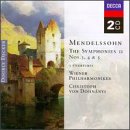| All Artists: Felix [1] Mendelssohn, Christoph von Dohnányi, Vienna Philharmonic Orchestra Title: Mendelssohn: The Symphonies, Vol.2 Members Wishing: 0 Total Copies: 0 Label: Decca Release Date: 5/11/1999 Genre: Classical Style: Symphonies Number of Discs: 2 SwapaCD Credits: 2 UPC: 028946023921 |
Search - Felix [1] Mendelssohn, Christoph von Dohnányi, Vienna Philharmonic Orchestra :: Mendelssohn: The Symphonies, Vol.2
 | Felix [1] Mendelssohn, Christoph von Dohnányi, Vienna Philharmonic Orchestra Mendelssohn: The Symphonies, Vol.2 Genre: Classical
|
Larger Image |
CD DetailsSimilar CDs
|
CD ReviewsDouble Decker or Box Set Michael B. Richman | Portland, Maine USA | 08/04/2003 (5 out of 5 stars) "This value-priced Double Decker featuring Mendelssohn's Symphonies Nos. 3-5 and three Overtures by Christoph von Dohnanyi and the Vienna Philharmonic is terrific. However, a potential problem arises if you plan to also buy the Double Decker featuring Symphonies 1 & 2. By this I mean that Decca/London has released Symphonies 1-5, and the three overtures featured on this title, as a space-saving, slim-paper box set (see my review). It basically comes down to whether you want to pay more money and get Die Erste Walpurgisnacht (Cantata for Chorus & Orchestra, Op. 60), which is also included on the Double Decker featuring Symphonies 1 & 2, but not on the box set. With either the two Double Deckers or the Box Set, you will get first rate performances of Mendelssohn's magnificent Symphonies." The Vienna Phil. is the star here Santa Fe Listener | Santa Fe, NM USA | 02/26/2007 (4 out of 5 stars) "I don't find that Dohnanyi has anything special to say here, since as usual he prefers to keep a tight rein on the music. But Mendelssohn himself was apparently a brisk, no-nonsense conductor who eschewed Romatnic expressiveness. If you want "classical" Mendelssohn, however, I'd be hard pressed to think of a better example. The real delight here is the incomparable sweetness, elegance, and precision of the Vienna Phil., who like to play for Dohnanyi. They make the rapid-fire perpetual motion in the finale of the Italian Sym. sound effortless. This Double Decca twofer was extracted from Dohanyi's complete symphony cycle, and considering that it contains Mendelssohn's three mature sympphonies along with the Hebrides and Meerstille overtures, the cream of the crop is right here. All tempos are standard, as are the interpretations. We don't get Karajan's authority and swagger or Abbado's charm, and of course there are great individual recordings of the Scottish and Italian symphonies by the score. But for elegance, dynamic sound, and the presence of the Vieena Phil., this is a set to seriously consider." A voice teacher and early music fan George Peabody | Planet Earth | 03/20/2007 (5 out of 5 stars) "MENDELSSOHN MAINTAINED ARTISTIC STANDARDS IN AN AGE WHEN MUSICAL VALUES WERE BEING ASSAILED AND RESHAPED.
Mendelssohn confronted musical Romanticism and struck a balance between tradition and reform. His music evinces a classical purity of structure and emphasis on tradtional craft; yet it was not unaffected by the new cult of self-expression which dramatically altered musical esthetics during the first few decades of the nineteenth century. The origins of almost all the music collected here lie in the same short period of Mendelssohn's early maturity and European travels at the end of the 1820's and beginning of the 1830's. It was during his travels in the Scottish Highlands that his 'Scottish Symphony'(#3) was conceived followed by the "Hebrides" Overture which he composed after seeing the rock formatons of Fingal's Cave. The following year his travels to Italy brought forth the 'Italian Symphony'(#4); just the opposite of the Scottish Symphony in mood (morose & dark); the sunlight of Italy inspired him to write "the jolliest piece I have ever done" (his own words). Around 1829 Mendelssohn began serious work on his fifth symphony for full orchestra, intended as a contribution to the tercentenary celebration of the Augsburg Confession in June 1830. At first referred to as the Kirchen-symphonie, the work became known as the 'Reformation' symphony, becasue of its use of Luther's chorale 'Ein feste Burg' as a kind of 'cantus firmus' in the finale, and the citation of the 'Dresden Amen' in the first movement. Mendelssohn has always been one of my personal favorites, and in his short life he has composed so much quality music in all genres and in his 'classical-romantic' way he stabalized and guided indirectly the way that the next generation of composers might go. The performance of Christoph von Dohnanyi and The Weiner Philharmonic suits me fine; I enjoy the discs very much, and really can not find much fault with them. I find that knowing some of the background of the origin of a work is most helpful in the enjoyment of it." |

 Track Listings (8) - Disc #1
Track Listings (8) - Disc #1